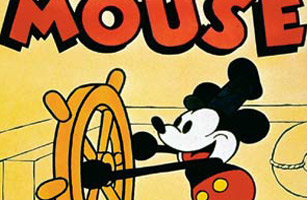
Nov. 18, 1928
In the fall of 1928, Walt Disney could claim three dubious assets: a new animated cartoon character called Mickey Mouse, three short silent films featuring the spunky rodent and an idea greater than perhaps even he imagined — adding sound tracks to his little films.
What he didn't have as he wandered New York City with one of those films, Steamboat Willie, tucked under his arm was cash or clout. He was just an unknown 27-year-old animator from California who needed musicians and sound-effects guys to record a score — and a distributor to promote his product.
It was seemingly an impossible dream. A year earlier Warner Bros. had released the first (partial) talkie, The Jazz Singer, and the movie biz was in a tizzy. The Al Jolson movie was awful, but the man sang and spoke. A long-sought miracle had arrived. Unfortunately, the camera, heavily blimped to prevent its whirrings from being recorded, was immobilized. Movies could talk but could no longer move gracefully. That's where Disney came in. His animators' drawn images were as free as any in movie history. It was relatively easy to pre-plan music, effects and dialogue so that they could be synched to the imagery. For example, all a conductor had to do was follow the beats Disney's people had marked on their work print. Even so, Disney had to spend a good deal of his dwindling capital getting a musical director to follow those cues. Then he had to spend several weeks lurking around screening rooms, trying to get Willie seen and heard.
To no avail. At which point enters legendary press agent Harry Reichenbach, master of old-fashioned ballyhoo (he had once faked a star's kidnapping to promote a film). Reichenbach was managing the Colony Theater in New York City, and he advised Disney to appeal directly to the public. Give me your little movie for a two-week run, he told Disney, and I'll give you $1,000 and make your mouse famous. The producer was dubious but desperate to make payroll — and he made the deal.
And so, on Nov. 18, history happened. There were bigger stars on the Colony's stage and screen, but Steamboat Willie got the press. Crowds created near mob scenes as they rushed to see this "riot of mirth." In truth, it was crude stuff. But Mickey turned a cow's tail into a hurdy-gurdy handle, and it mooed music as he cranked away. Another bovine's teeth became a xylophone on which he beat out a tune. In short, Willie had what its more pretentious competitors lacked—energy and freedom. And its creator was on his way to fame, riches and immortality.